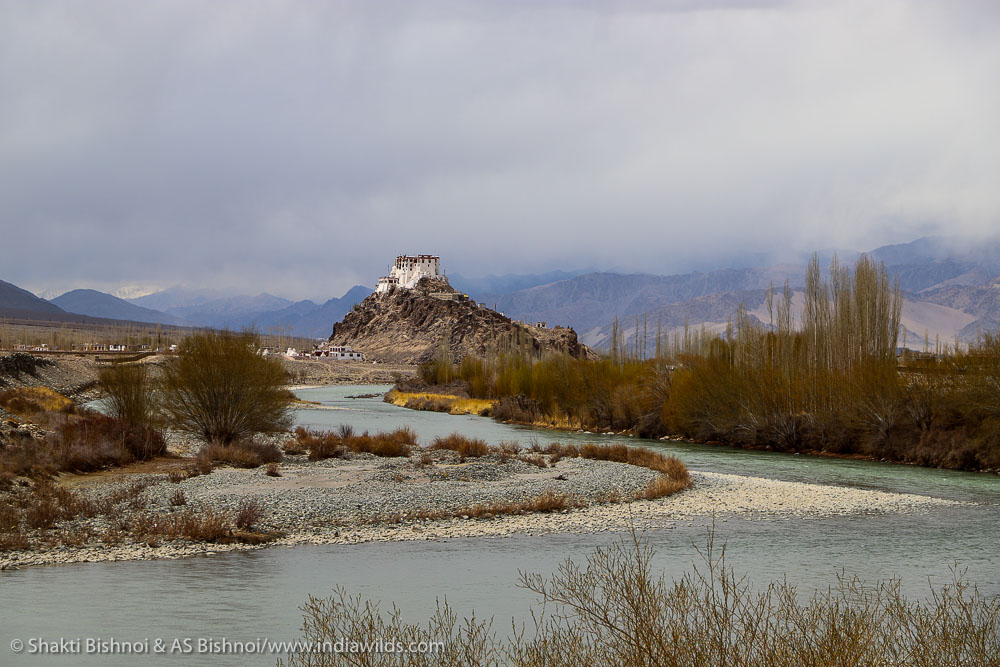Ladakh: An Enchanting Landscape
Ladakh is India’s highest plateau. Ladakh also refers to the Land of Passes due to the mountainous terrain. The Tibetan plateau is in the east and Lahaul and Spiti regions are in the south. The Kashmir and Jammu regions are on the west. Tibet came under Chinese control in 1950. After India and Pakistan got independence from British rule, the Baltistan area of Ladakh in the north west came under Pakistan’s illegal occupation following a war.

Ladakh is also known as a cold desert. The biting cold is due to the high altitude. Most of Ladakh is above 3000 m altitude. Leh, the capital of Ladakh is situated at 3524 m. Ladakh is in the rain shadow region of the Himalayas and receives scant rainfall. Due to this Ladakh experiences dry climate and it is said that one can get sunstroke if you step out in the sun for prolonged period and can get frost bite from the chilling cold if you remain in shade without protection.
Apart from the mighty Indus or Sindhu river originating in Tibet region in Bokhar Chu glacier, the other important rivers are Shyok and Nubra.
Ladakh region used to be hub of trade and commerce to China. Post Independence wars between India and Pakistan and then the Sino-Indian war in 1962 put an end to remnants of the historical trade. The high-altitude regions are not conducive for farming and hence are inhabited by either nomadic pastoralists or agro pastoralists, e.g the Changpa nomads.
Wildlife
As a transitional zone between Tibetan plateau and the Karakoram mountain range, Ladakh harbours species from both these regions. A few corners of Ladakh are still unexplored and inaccessible due to security considerations while a few others are facing excessive tourism. The Himalayan high-altitude wetlands, such as Pangong Tso, Tso Moriri and Tso Karare are unique ecosystems.

Eight wild species occur in these high elevation steppes and mountain regions of Ladakh, with six listed as endangered and protected. They are the blue sheep, Ladakh Urial, Asiatic ibex, Tibetan Wild ass or kiang, Tibetan gazelle, Tibetan Aantelope, Tibetan Argali and Wild Yak. Two species of hare, five species of Pika, three species of vole and two species of marmot complement the herbivore group. The snow leopard is the most iconic animal of the trans-Himalayan region, resulting in the creation of large protected areas for its conservation (e.g Hemis National Park). There are also smaller predators such as Red fox, Tibetan wolf, and Pallas cat, lynx and few more. These are the residents species well adapted to the cold and harsh environment of Ladakh.

Ladakh is also an important migratory route for birds between Central Asia and the Indian sub-continent. More than 310 types of birds and 20 mammalian herbivore species are recorded here. People often flock to Ladakh to sight some of these species like the Black-necked cranes.
Our Journey in the Mystic Landscape
Ladakh is scarcely populated. As a result, the pristine beauty of this rugged mountainous landscape has mostly remained unmolested. Each hill appears to have a unique shade and travelers are often suggested by locals to look back as the view behind can be entirely different.

Ladakh gives you feeling of being at home and in the lap of nature. We have been visiting this mystic land in search of elusive snow leopard for last three years without any luck. My daughter when she was just 3 years old, once said, our home is in Ladakh so what are we doing here in city? I could convince her by saying that being in Armed forces makes us move like a gypsy but our final destination will be this place. She has accompanied us on all our trips, irrespective of how arduous or inaccessible the terrain may be. She was in fact more comfortable than us in high altitudes of Ladakh.
Our first visit into this hinterland was to explore the monasteries and tourist locations which generally find pride of place in the tourist maps. It was a wonderful trip and we explored length and breadth of Ladakh. Our next visit was equally enchanting, but we had shifted focus to sighting the elusive snow leopard. We preferred home stay and headed for Rumbak.
It was 6 hours of trek, crossing rivulets, mountains, and one can feel like explorers. Our guide Tundup, a very energetic and ambitious young man, took us through the mighty Himalayas with ease and at several locations we saw pug marks and markings. That gave us feeling that we were very near to it. The Nomads of Himalayas say that when you want to meet the snow leopard, it does not appear. The stories of sighting narrated by Rumbak homestay was as if it is daily chore for them. However, the fact is that the entire world is dying to have glimpse of this elusive Snow Leopard. Such is the camouflage, stealth as well as difficulty in sighting a snow leopard that it is often called as The Ghost of the Mountain. We stayed for two days and enjoyed our stay with eyes fixed on peaks throughout the day, but to no avail.

Our hearts were filled with joy sighting other species like blue sheep, Ladakh Urial, Asiatic ibex. We also sighted some beautiful birds including some Tibetan species uncommon in other parts of the country like Golden eagle, Lammergeier and Himalayan Griffon vulture. Many other local species like Chukar, Tibetan Partridge, Tibetan Snowcock, Tibetan Snowfinch, Streaked Rosefinch, Robin Accentor were frequently sighted.
After two days we changed our plan and wanted to head for Ulley, the den of Norbu hoping for a sure shot sighting of the elusive cat. The route was full of adventure and frequent halts were memories to cherish till date.
In Search of Snow Leopard-ULLEY
After driving from Leh on impeccable road for 50 Km, our Innova took a detour and imposing views of craggy and jagged mountains appeared closer, their greyish hues unfolding and started dominating the view. In a rare display of defiance, I see a speck of green here and a shrub there. As we zig-zag through the flat mud roads, native yaks playfully gather to feast on these patches with great relish.

Piercing the silence of the valley, our car roars ahead with dust flying around, into the heart of Snow Leopard hinterlands. This is a physical and psychologically challenging trail. The vehicle bounced and swayed on the sharp bends, dangerously negotiating along the edge of deep gorges. After a nerve wrecking four-hour ride, our bones felt shaken. We reached our destination and jumped out of the vehicle to regain our composure. A sense of triumph prevailed that we were finally in Snow Leopard country.

These mountains offer a perfect place to find peace within. During winters the trek becomes tough and now a days due to rain, it is more dangerous as landslides have become frequent. Climate change is having its impact.
Nurbu Residences
The view from the Nurbu’s residence was panoramic and few scattered houses were offering the desired privacy and silence in the valley. The rugged appeal and the grey and black hues of the mountain covered with season’s last snow is indescribable and was truly exhilarating. Here one can experience the Himalayas in its true grandeur. A sense of awe and reverence often fills the traveler.
The path traverses into what is called balcony walk, filled with perilous looking terraces and dilapidated mud houses made of locally available sources and stacked stones, giving a glimpse of those of who lived a life on the edge till a few decades ago. During the last day of our visit, unexpectedly it snowed heavier than usual. There were few foreigners sitting under umbrella gazing at the distant mountains with optimistic eyes. One moment’s sighting of a snow leopard can fulfill lifelong dreams. We too were winding up our stay and to head towards Leh and we saw Nurbu frantically indicating snow leopard at the edge of hill. We aligned our eyes in the particular direction and saw with binoculars the elusive Ghost of the Mountains walking gracefully on the edge for at least 5 mins. The snow leopard then disappeared on the other side of hill. Even though we were hopeful of getting a sighting, we knew there are many people who have never sighted a snow leopard despite visiting again and again. We were stunned as realization dawned on us as to how blessed we were to have our dreams come true.

Growing Barley : A conscious movement in Ladakh
Barley is a staple food in Ladakh. For those people who grew up in Ladakh, growing barley and sustaining on barley, was a way of life. The old people would grow barley and pretty much survive on what they grew. If a family had a plot of barley, they were considered to be wealthy! As wonderful as barley is, it is important that it be relatively fresh, which means that it should be cultivated constantly. And through the history of Tibet, famine was avoided by releasing stored barley from the government granaries when the harvest was not good. Macro Pallis noted in his classic peaks and lamas, 1939 published “The inhabitants of these villages must surely be some of the happiest on the face of the earth”.
Now nearly all the young people have moved to Leh, the capital city of Ladakh, Leh, and to the other Indian cities. The fields where, traditionally people had grown barley and other grains either remain uncultivated or are now being used to build houses for tourism purpose. The cows, goats, sheep and other animals that flourished all over Ladakh have almost disappeared, and people are eating exclusively food shipped from the lower parts of India. In Ladakh the food was grown organically. However, the food that comes from other cities of India to Ladakh are used using toxic synthetic fertilizers. These days more and more people are drawn towards experiential tourism. Unfortunately, with the traditional way of life in Ladakh disappearing, many such tourists will be disappointed and will stop coming.
In Ladakh, the villages should once again be providers of barley and other grains, fertilized organically in the traditional way with cows, goats, sheep and other animals. This would be a first step in the revival not only of ladakh economy and health, but of that of the entire Himalayan plateau, including Tibet, Nepal and Bhutan.
Ladakh should give this precious, healthy heritage, the ancient way of growing the most healthy of staples, to the people of the world, starting with their neighbours in the lower parts of the India, who would benefit greatly from this infusion of health and well-being. It would be pertinent to mention that Punjabi Sikhs eat organic barley, remembering that it is the blessing of guru Nanak, who according to a sikh tradition, visited Ladakh and left his body imprint on the stone on a desert roadside. Local people call this “lama Guru”. So this practice of growing barley would be welcome.
These days when trucks come from rest of India making deliveries to Ladakh, they return empty. And if Barley is grown again, then trucks will-return carrying organic grain from Ladakhi villages to sustain all of India.
To accomplish this, which can also be a worldwide model for health, economics and sustainability, funding is needed. While government support would be marvelous, given the many bureaucratic hurdles in India, private funding is essential and we are seeking thoughtful people to help us start and sustain this worthy project to save Ladakh and its culture, to benefit the world.
Someone had rightly said “one decade from now, you will be more disappointed by the things you didn’t do, than by the ones you did”. For all those who seek adventure and seek to experience nature at it’s best, Ladakh should be top on your list of must visit places.
- Ladakh: An Enchanting Landscape - 28 June,2022
- Changes observed during a decade long love affair with Chilika - 31 March,2022
- Journey to Leopard Country - 30 December,2021












Leave a Reply